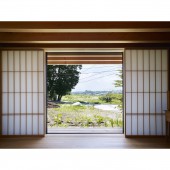Yatsugatake Villa Residence by Kiyotoshi Mori and Natsuko Kawamura |
Home > Winners > #129187 |
 |
|
||||
| DESIGN DETAILS | |||||
| DESIGN NAME: Yatsugatake Villa PRIMARY FUNCTION: Residence INSPIRATION: With exterior walls arranged to resemble a fan, the house provides framing for the landscape, maximizing the location on a plateau surrounded by fields and trees with panoramic view of mountain ranges in the distance. It is a summer resort, slightly cooler than humid summers in Tokyo, and yet the sun rays are strong and the winters are cold. The roof was extended to block direct sunlight in the summer and side walls to keep the western sun out, resulting in a series of tubular forms. UNIQUE PROPERTIES / PROJECT DESCRIPTION: The exterior is characterized by three modern trapezoid tubes, deforming the traditional Japanese space under deep eaves to frame the landscape in four directions. The form was derived from meticulous calculation of precipitation, the sun's movement in summer and winter, and the thermal environment. Shoji paper screens offer a space filled with soft light iconic of Japanese culture when closed, and switch to the majestic scenery framed by the walls when opened, providing two alternating scenes. OPERATION / FLOW / INTERACTION: Considering the cold winter, the building is built in a fan shape, open to the south, in order to maximize the sunlight while the sun moves. On the other hand, in summer, the roofs and walls of the trapezoid tubes block the strong sun rays, creating shadows inside, and windows at the north and south let the breeze through to cool the airy space. The layout, guided by the thermal environment, provides various interior scenes of varying depths as seen through the openings that connect the spaces. PROJECT DURATION AND LOCATION: The project was completed in Hokuto-City, Yamanashi, Japan in 2012 FITS BEST INTO CATEGORY: Architecture, Building and Structure Design |
PRODUCTION / REALIZATION TECHNOLOGY: Contrary to the contemporary style guided by precipitation, sun rays and the surrounding environment, the construction of the house incorporates traditional Japanese wooden construction methods, with earthquake-resistant walls and large openings. Traditional Japanese techniques and components are used throughout, including plastering on the curved openings and fittings such as shoji and ranma (partition with ventilation and daylighting functions), creating a vernacular architecture. SPECIFICATIONS / TECHNICAL PROPERTIES: Site Area 691.00m2 Total Floor Area 110.01 m2 (1F 71.65 m2, 2F 38.36 m2) W17,400mm x D12,300mm x H6,139mm TAGS: Villa, Sun light, Wind, Fan-shape, Wooden, Mountain, Three adjacent shells, Sho-ji, Eaves, Farming RESEARCH ABSTRACT: Three trapezoid tubes with north-south openings sit wide open towards the south to maximize winter daylight. Glass surfaces are set back from the roof edge to avoid direct south sun rays in summer. Side walls are arranged to block the west sun. The footprint is set back from the roof edge, partly to reduce soil excavation (deep foundation below the frost line is required), creating a sitting area free from rain dripping from the roof. It is a modern version of traditional Japanese engawa space. CHALLENGE: In Japan, especially in rural areas, the number of carpenters capable of building elaborate wooden houses is decreasing, and it was difficult to find a builder who could construct a building with a unique (challenging) design. In spite of the modern design, Japanese cedar and plastering materials are used, and shoji screens as well as other traditional materials handed down from generation to generation are fit in by the indigenous module method, enabling the definition of a Japanese space. ADDED DATE: 2021-07-30 11:46:08 TEAM MEMBERS (2) : Kiyotoshi Mori and Natsuko Kawamura IMAGE CREDITS: Photography: Toshiyuki Yano |
||||
| Visit the following page to learn more: https://www.mds-arch.com | |||||
| AWARD DETAILS | |
 |
Yatsugatake Villa Residence by Kiyotoshi Mori and Natsuko Kawamura is Winner in Architecture, Building and Structure Design Category, 2021 - 2022.· Read the interview with designer Kiyotoshi Mori and Natsuko Kawamura for design Yatsugatake Villa here.· Press Members: Login or Register to request an exclusive interview with Kiyotoshi Mori and Natsuko Kawamura. · Click here to register inorder to view the profile and other works by Kiyotoshi Mori and Natsuko Kawamura. |
| SOCIAL |
| + Add to Likes / Favorites | Send to My Email | Comment | Testimonials | View Press-Release | Press Kit |
Did you like Kiyotoshi Mori and Natsuko Kawamura's Architecture Design?
You will most likely enjoy other award winning architecture design as well.
Click here to view more Award Winning Architecture Design.








